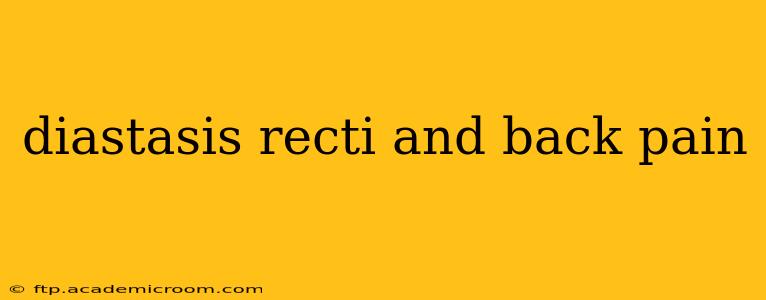Diastasis recti, the separation of the abdominal muscles, is often associated with pregnancy and postpartum recovery. While it's commonly thought of as an abdominal issue, many women experience back pain alongside diastasis recti. This article explores the connection between these two conditions, offering insights into causes, symptoms, and effective management strategies.
What is Diastasis Recti?
Diastasis recti refers to the widening of the linea alba, the connective tissue that runs down the center of your abdomen, separating your right and left rectus abdominis muscles (your "six-pack" muscles). This separation can occur during pregnancy due to the stretching and thinning of the abdominal muscles to accommodate the growing baby. While it often improves postpartum, it can persist in some women, leading to various physical discomforts.
How is Diastasis Recti Linked to Back Pain?
The relationship between diastasis recti and back pain is multifaceted. When the abdominal muscles are separated, the core's stability is compromised. This instability forces other muscles, including those in the back, to overcompensate to maintain posture and balance. This increased strain can lead to:
- Increased lumbar lordosis: The inward curve of your lower back can become exaggerated, placing more stress on the lower back muscles and intervertebral discs.
- Muscle imbalances: The overworking of certain back muscles while the abdominal muscles are weakened creates muscle imbalances, leading to pain and discomfort.
- Poor posture: A weakened core makes it difficult to maintain proper posture, contributing to back pain.
- Pelvic instability: A compromised core can affect pelvic stability, leading to pain radiating to the lower back and hips.
What are the Symptoms of Diastasis Recti and Back Pain?
Symptoms can vary, but common indicators include:
- Visible abdominal bulge: A noticeable separation or doming of the abdominal muscles, particularly when performing abdominal exercises or straining.
- Lower back pain: Aching, stiffness, or sharp pain in the lower back, often worsening with activity.
- Pelvic pain: Discomfort in the pelvic region.
- Poor posture: Slouching or difficulty maintaining an upright posture.
- Constipation: Difficulty with bowel movements due to compromised abdominal muscle function.
- Incontinence: Leakage of urine or stool.
Can Diastasis Recti Cause Back Pain?
While diastasis recti doesn't directly cause back pain in all cases, it significantly increases the risk. The weakened core destabilizes the spine, leading to compensatory strain on the back muscles, as described above. The degree of back pain experienced varies greatly depending on the severity of the diastasis, individual factors (such as pre-existing back conditions), and other lifestyle factors.
How is Diastasis Recti and Back Pain Diagnosed?
A physical examination by a healthcare professional (physical therapist, obstetrician, or physician) is crucial for diagnosing diastasis recti and assessing its contribution to back pain. This usually involves a physical assessment to measure the width of the abdominal separation and assess core muscle function. Imaging studies (like ultrasound) are generally not necessary for diagnosis but might be used in complex cases to rule out other conditions.
How is Diastasis Recti and Back Pain Treated?
Treatment often involves a combination of approaches:
- Physical Therapy: A tailored exercise program focused on core strengthening and improving pelvic floor function is crucial. This often involves gentle exercises to avoid further straining the abdominal muscles.
- Postural Correction: Learning and practicing proper posture techniques can significantly reduce back pain associated with diastasis recti.
- Manual Therapy: Techniques like massage and mobilization may help alleviate muscle tension and improve mobility.
- Pain Management: Over-the-counter pain relievers (like ibuprofen or acetaminophen) might help manage pain temporarily. In some cases, a physician might recommend other pain management strategies.
What Exercises Should I Avoid with Diastasis Recti and Back Pain?
Avoid exercises that increase intra-abdominal pressure and further stress the weakened abdominal muscles. These include:
- Traditional crunches: These put excessive strain on the linea alba.
- Plank variations (unless modified): Standard planks can exacerbate diastasis recti if performed incorrectly.
- Sit-ups: Similar to crunches, these place undue pressure on the abdominal muscles.
- Heavy weight lifting: Lifting heavy weights without proper core engagement can worsen the separation.
Consult with a physical therapist to determine safe and effective exercise modifications.
When Should I See a Doctor?
It’s important to seek professional help if you experience persistent back pain alongside abdominal separation. A healthcare provider can accurately diagnose the condition and recommend appropriate treatment. Consult a doctor immediately if you experience severe back pain, pain that radiates down your leg, or any other concerning symptoms.
This information is for educational purposes only and does not constitute medical advice. Always consult with a healthcare professional for any health concerns or before making any decisions related to your health or treatment.
